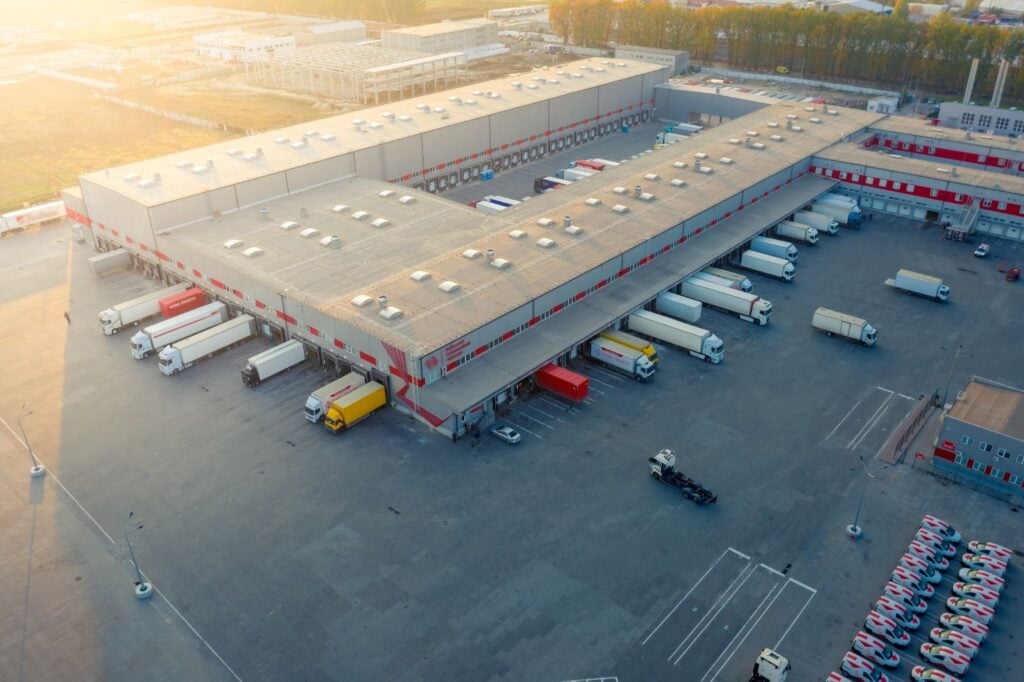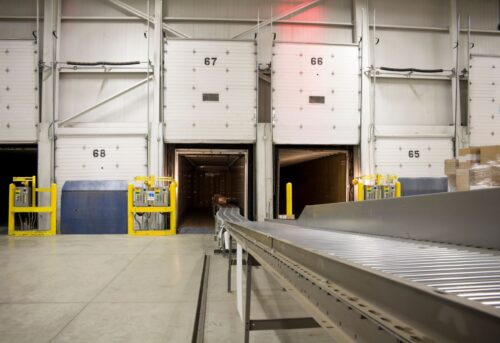11 Types of Warehouses: A Complete Guide to Their Uses

Warehouses are essential to the supply chain and logistics industry. They provide storage facilities for a company’s upstream and downstream supply chain inventory until it is distributed to its final destination. These storage facilities ensure the smooth flow of goods through the supply chain from the manufacturer to the customer.
However, not all warehouses are created equal. Different types of warehouses serve distinct and specific purposes in the logistics chain and have unique features, advantages, and disadvantages. Let’s take an in-depth look at the types of warehouses available, their uses, and how they fit into the broader supply chain.
Types of Warehouses
Here are some of the various types of storerooms and their specific purposes in the overall supply chain management.
Public Warehouse
As the name suggests, a public warehouse is a storage facility offering temporary storage space to the public. Third-party logistics (3PL) providers operate these public warehouses. They give warehousing services to businesses that need extra storage space but do not have the resources or infrastructure to maintain their warehouses.
Public warehouses provide flexibility and offer value-added services such as inventory management, order processing, and transportation services. Businesses can rent as much or as little space as needed and adjust their storage needs as inventory levels change. These warehouses also can service multiple clients, spreading out the costs of maintaining the facility.
However, businesses have limited control over storage conditions since the space gets shared among multiple clients and enterprises. Additionally, because a third party manages the warehouse, there may be less direct communication and oversight over handling goods.
Distribution Center
A distribution center (DC) is a warehouse designed to receive, store, and ship products to multiple destinations. Distribution centers play a critical role in the supply chain and act as a hub for the movement of goods between suppliers, manufacturers, and retailers. They are located near major transportation hubs to facilitate the efficient movement of goods.
Distribution storerooms ensure that products get delivered to their final destination promptly and cost-effectively. They are more extensive and complex than standard stores and handle high volumes of goods. They also act as a consolidation point for goods from multiple suppliers, which allows retailers to receive various products from different manufacturers.
Distribution centers use advanced inventory management systems and real-time data to optimize inventory levels and reduce waste. They also provide value-added services such as labeling, packaging, and assembly. These services help to streamline the supply chain and reduce costs for retailers and manufacturers.
Smart Warehouse
A smart warehouse is a highly advanced and automated storeroom. It leverages the latest technologies to improve warehouse operations’ efficiency, accuracy, safety, and sustainability. Intelligent warehouses are more responsive, agile, and adaptable to changing business needs and customer demands.
One of the key features is the use of IoT devices such as sensors, RFID tags, and beacons that collect real-time data on inventory. The data is then analyzed to optimize warehouse operations, reduce waste, and improve decision-making. Smart warehouses also use automated technologies to improve the speed and accuracy of warehouse operations.
Another critical aspect of an intelligent warehouse is safety. Advanced safety technologies, such as machine vision and proximity sensors, ensure workers and equipment operate safely and efficiently. Smart warehouses are often designed to be more sustainable and environmentally friendly, using renewable energy such as wind power.
Private Warehouse
Private warehouses are owned and operated by a single company for exclusive use. They are typically used by large companies with a high inventory volume and a need for a dedicated space to store and manage their products.
In a private warehouse, businesses have greater control over the conditions in which their products get stored and the processes used to manage them. It also offers greater security and confidentiality since one firm uses the store. This confidentiality and control improve the products’ quality and consistency and reduce damage or loss risk.
Businesses also have the advantage of customizing their private warehouses to meet the company’s specific needs. However, building and maintaining a private warehouse can be expensive, particularly for smaller businesses.
Cold Storage Warehouse
Cold storage warehouses use advanced refrigeration and temperature control systems to store perishable goods and temperature-sensitive products such as fresh produce, frozen foods, pharmaceuticals, and chemicals. These warehouses are maintained at low temperatures to preserve the quality and freshness of the products.
Cold storage warehouses are divided into chambers or rooms, each with temperature and humidity controls. These divisions accommodate a wide range of products with varying temperature requirements. Maintaining consistent temperatures is a challenge in this type of warehouse.
Cold storage warehouses also use specialized equipment and packaging materials to protect products during transport and storage. These include insulated containers, pallets, and packaging materials designed to maintain the temperature of the products and prevent exposure to moisture or other contaminants.
On-Demand Warehouse
On-demand warehouses are also known as flexible or shared warehouses. These provide businesses with access to temporary or short-term storage space as needed. Enterprises quickly and easily scale their warehousing operations based on changes in demand without requiring a long-term lease or investment in fixed infrastructure.
3PL providers or technology platforms operate these warehouses. They broker the businesses needing storage space with available warehouse capacity. These warehouses can be especially useful for small companies or ecommerce retailers with fluctuating inventory levels or seasonal peaks in demand.
On-demand warehouses are highly flexible, as businesses can quickly add or reduce warehouse space. These storerooms offer various services and features and are geographically reachable by customers. However, these warehouses have limited space during peak seasons, and businesses have less control over them.
Government Warehouse
These storerooms are storage facilities owned and operated by federal, state, or local government agencies. Government warehouses store a wide range of goods and materials owned by the government or ones seized or confiscated by law enforcement agencies.
These warehouses provide a secure and controlled storage environment for government-owned assets, such as military equipment, vehicles, and supplies. Governments also store emergency and disaster relief materials, such as food, water, and medical supplies—ensuring a steady supply of these materials in the event of emergencies.
Government warehouses may also store goods and materials seized or confiscated by law enforcement agencies, such as drugs, weapons, or counterfeit merchandise. These items get held in government custody until used as evidence in a court case or safely disposed.
Bonded Warehouse
A bonded warehouse stores imported goods yet to be cleared through customs or goods intended for export. Government agencies such as customs or tax authorities run this type of warehouse. In bonded warehouses, businesses do not pay duties or taxes until the release of their goods for sale or export.
Bonded warehouses allow you to defer duties and taxes until the goods are released for sale or export. They also allow for the sale of goods from the warehouse, generating revenue from the sale of the goods and paying for the delayed payment of customs duties.
These warehouses provide secure storage for valuable or sensitive goods, streamlining the customs clearance process. They allow you to make any necessary adjustments to shipments before the goods get released for sale or export.
Cross-Docking Warehouse
A cross-docking warehouse is a DC that facilitates the direct transfer of goods from incoming trucks to outgoing trucks, with little or no storage. Cross-docking aims to reduce the time spent in warehouses, thereby reducing inventory holding costs and improving the speed of delivery.
In a typical cross-docking operation, goods are received from various suppliers and are sorted and consolidated based on their destination. They are then loaded onto outgoing trucks, transporting them directly to their destination without additional handling or storage, increasing efficiency.
Cross-docking is particularly useful for businesses that deal with high-volume, low-value goods that require fast turnaround times. These goods include perishable goods, seasonal products, or goods in high demand for a short period.
Consolidated Warehouses
Consolidated warehouses allow multiple suppliers to concentrate their shipments into a single load. This reduces transportation costs and improves efficiency by consolidating multiple shipments into a single shipment that is more cost-effective to transport.
Consolidated warehouses enable organizations to enjoy economies of scale by shipping small quantities of goods simultaneously, reducing transportation costs. These warehouses also improve efficiency by reducing the number of handling and transportation steps required Improving supply chain performance and reducing delivery times.
Hazmat Warehouse
A hazmat warehouse, a hazardous materials warehouse, stores dangerous materials. These substances pose a potential risk to human health or the environment due to their chemical or physical properties.
Hazmat warehouses follow strict regulations and safety standards, ensuring they are not accidentally released or spilled. They have specialized storage systems, such as secondary containment, ventilation, and fire suppression systems. These systems minimize the risk of spills, leaks, or fires.
Hazardous material warehouses allow you to store hazardous materials in compliance with government regulations, minimizing risks. However, these warehouses are relatively costly to operate due to their specialized construction and facilities.
What To Consider When Choosing a Warehouse

Choosing the right warehouse for your business is crucial for overall business performance. Here are factors to consider when choosing a warehouse.
- Location. Your warehouse should be reachable by suppliers, customers, and transportation networks to reduce transportation costs and improve delivery times.
- Size and capacity. You should choose a warehouse accommodating your current inventory needs and future growth.
- Security. The warehouse should have proper safety and security measures to protect your inventory and staff from theft, damage, or accidents.
- Cost. The cost of the warehouse must be within your budget and aligned with the value it provides to your business.
- Regulatory compliance. You must comply with all relevant regulations and guidelines when choosing a warehouse.
- Accessibility: The warehouse should be easily accessible by road, rail, or water, depending on your transportation needs.
- Flexibility. The warehouse should be flexible enough to accommodate inventory or business operations changes.
Frequently Asked Questions
Let’s look at some questions people ask about warehouses.
What is the most common type of warehouse?
Private warehouses. These warehouses are standard across the supply chain as they offer organizations the most control over inventory management.
How important is warehousing for the supply chain?
Warehousing plays a crucial role in streamlining an organization’s supply chain operations. It ensures the smooth flow of goods and materials downstream and upstream of the supply chain, maintaining consistency in its operations.
Is a warehouse management system necessary for all warehouses?
Yes. A warehouse management system helps businesses streamline their warehousing activities and have real-time data and visibility into their warehousing processes.
Final Thoughts
As the demand for faster and more efficient logistics operations continues to grow, the importance of warehousing will only continue to increase. Various types of warehouses cater to different industries and needs.
Understanding the types of warehouses and their uses is crucial for businesses relying on efficient supply chain management. Choosing the correct warehouse type can help you optimize inventory management and order fulfillment, maintain a competitive edge and logistics and improve customer satisfaction.
